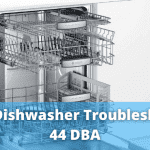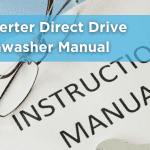Table of Contents
If you’re facing the common issue of your KitchenAid dishwasher not draining, you’re in the right place! This guide will help you navigate through various solutions and troubleshooting steps.
Understanding the Problem: Why Isn’t Draining?
Water in your dishwasher can be due to various reasons. Pinpointing the exact moment you notice the standing water can be crucial in identifying the problem.
- End of the Cycle: It is normal for some water to remain at the filter/sump area to prevent seals from drying.
- Garbage Disposer Connection: Ensure the knockout plug is removed.
- Obstructions: Check for blockages in the drain or the garbage disposer.
- Door Interruptions: The Start/Resume indicator will flash if opened during a cycle.
- Water Supply Valve: This must be on for the dishwasher to fill.
- Overfill Protection Float: It should be free of obstructions and move freely.
- Drain Hose Position: Should be 20″ (50.8 cm) above the floor to prevent siphoning.
Use an air gap if the drain hose is connected to house plumbing lower than 20″ (50.8 cm) above the subfloor or floor. See this video to learn how to connect the dishwasher to the drain.
Note: This guide can help if you have one of many KitchenAid dishwasher models, like shown in this table.
| Model Number |
|---|
| 4KPDI620T0 |
| 4KPDI620T1 |
| 4KPDI620T2 |
| 4KPDI620T3 |
| 4KUDA220T0 |
| 4KUDA220T1 |
| KDFE104DSS0 |
| KDTE104DSS0 |
| KDTE104ESS1 |
| KDTE204DSS0 |
| KDTE254ESS2 |
| KDTE334DSS0 |
| KDTM354DSS4 |
| KUDC10FXSS5 |
| KUDS01FLSS0 |
| KUDS01FLSS6 |
| KUDS30FXSS5 |
| KUDS30IXSS4 |
| KUDS35FXSS5 |
| KUDS35FXSS9 |
| KUDS35FXSSA |
What’s happening?
- Dishwasher drains a little (or sounds weird when it tries)
- Maybe because: There’s something stuck in the filter or drain or the garbage disposal part is blocked.
- Dishwasher doesn’t drain at all
- Maybe because: Some parts inside the dishwasher aren’t working, or the garbage disposal plug is still there.
7 Easy Solutions to Get Rid of This Problem
1. FILTER CHECK
What to do? See if your dishwasher’s filter is blocked with food or other stuff.
Steps:
- Open your dishwasher.
- Take out the bottom rack.
- Find the filter inside (it might be under a rotating water arm).
- Please remove the filter (you might need to turn it like a lid).
- Clean any junk off the filter.
2. CLEAN THE BOTTOM WATER AREA
What to do? Clean the area where water collects at the bottom.
Steps:
- Turn off the dishwasher from the power socket.
- Remove any water from the bottom using a container or a wet vacuum.
- Find and remove the filter and any covers.
- Take out anything that shouldn’t be there.
- If you can see the water pump wheel, ensure it’s not blocked.
3. GARBAGE DISPOSAL CHECK
What to do? Ensure there’s no blockage if your dishwasher drains into a garbage disposal.
Steps:
- Clean the garbage disposal.
- Use a safe cleaner to remove any blockages.
- Disconnect the hose between the dishwasher and the disposal. Ensure there’s an open hole (not a plug) for water to go through.
4. CHECK THE ONE-WAY VALVE
What to do? There’s a valve that lets water out but not back in. Make sure it’s working.
Steps:
- Find the valve (it might be inside the dishwasher or where the drain hose connects outside).
- Make sure it opens and closes. If it doesn’t work, get a new one.
5. DRAIN HOSE CHECK
What to do? Ensure the hose that drains water isn’t blocked.
Steps:
- Turn off the dishwasher from the power socket.
- Check the hose where it connects under the sink. Clear out any blockages.
- Take off the cover at the bottom front of the dishwasher to see the hose.
- Disconnect the hose from the dishwasher. Clear out any blockages.
- Also, check if a valve in the hose is not working.
6. WATER PUMP CHECK
What to do? The pump pushes out water. Make sure it’s working.
Steps:
- Turn off the dishwasher from the power socket.
- Access the pump (you might need to lean the dishwasher back).
- Check the pump wheel (impeller). Make sure it spins.
- Remove the pump.
- Test the pump with a tool called a multimeter. If it’s not working, get a new one.
7. CHECK THE DRAIN OPENER
What to do? Some dishwashers have a special valve that opens for draining.
Steps:
- If your dishwasher has one, test it with a multimeter.
- If it’s not working, get a new one.
In conclusion, if your KitchenAid dishwasher is not draining properly, several potential causes and solutions should be considered. You can often diagnose and fix the issue by systematically checking for blockages, ensuring proper connections, and inspecting key components like the filter, one-way valve, and water pump.
Remember to refer to your dishwasher model and follow safety precautions while performing maintenance or repairs. Hopefully, these steps will resolve the drainage problem and keep your dishwasher running smoothly. If the issue persists, seek professional assistance or contact KitchenAid customer support for further guidance.
FAQ’s
Why is my KitchenAid dishwasher not draining?
Various reasons can cause a KitchenAid dishwasher not to drain, such as clogs, a faulty drain pump, or issues with the drain hose.
What is the main cause of a dishwasher not draining?
The most common cause of a dishwasher not draining is a clog in the drain or filter. Over time, food particles and debris can accumulate and block the path, preventing water from draining.
What is the most common problem with a KitchenAid dishwasher?
The most common problems with KitchenAid dishwashers include not draining, starting, or cleaning dishes properly. Component failures, such as a faulty control board or a malfunctioning door latch, can also occur but are less frequent.
How do I test my KitchenAid dishwasher drain pump?
- Disconnect Power: Always unplug the dishwasher or turn off the circuit breaker before working on it.
- Access the Drain Pump: You may need to remove the dishwasher’s toe kick or lower panel to get to the drain pump.
- Check for Obstructions: Inspect the pump for any visible debris or obstructions before testing.
- Test with a Multimeter: Disconnect the drain pump’s wiring. Set your multimeter to the ohms setting. Place one probe on each terminal. A functioning pump should give a reading between 20 and 40 ohms. The pump might need to be fixed if the task is outside this range or there’s no reading.








[…] which is something to bear in mind. It includes a detergent and rinses aid dispenser and a drain hose, wash levels of 7.0, and 3 nylon racks with five wash […]
[…] Also check out our latest article on kitchenaid dishwasher is not draining. […]